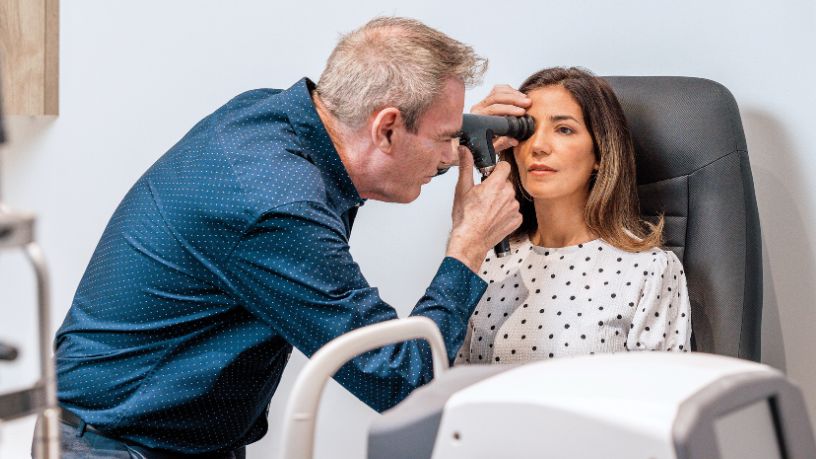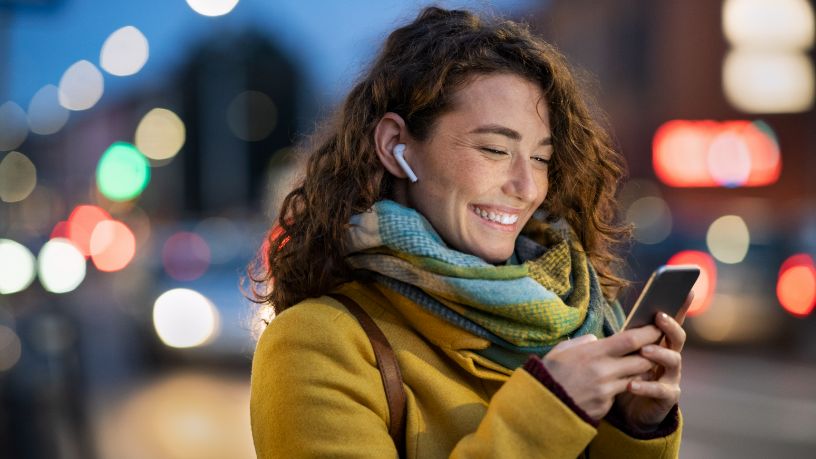On this page
Key takeaways
- Hearing aid technology can significantly improve your quality of life, regardless of age.
- Hearing aids can be small, sophisticated and budget friendly.
- Modern hearing devices come with Bluetooth connectivity.
The benefits of hearing aids
Struggling to follow the conversation in a noisy environment, asking people to repeat themselves and turning up the volume on the TV are all early signs that you might be experiencing hearing loss.
As social beings, hearing is critical. Restricted hearing can lead to social isolation and linked mental health issues such as anxiety and depression.1
This can be challenging for older people with significant hearing loss, but although hearing loss impacts more older people, it can affect people at any age.
“There is often a reluctance towards hearing aids among younger people,” says Simon Davis, hearing services manager at Bupa Hearing.
“They see them as an old person’s device, and as a result many people delay getting hearing aids for longer than they should. It takes nearly 9 years on average for a hearing aid candidate to adopt the technology.2 But detecting and improving hearing loss is key to improving your hearing and wellbeing.”
Why hearing aids aren’t what they used to be
The culture around hearing aids is changing, and this largely comes down to hearing aid technology, which has come on in leaps and bounds over recent years. For a start, hearing aids are much smaller than they used to be, and this isn’t just beneficial in terms of how they look.
“I’ve found that the main reason younger people tend to be reluctant to use hearing aids is because they’re worried the device will feel like they’re wearing earplugs,” says Davis.
“This is no longer a problem, as the small component that inserts into the ear is tiny on modern devices, and no longer blocks the ear canal.”
We’ve also seen the advent of microchips and digital technology in recent years. This has helped further miniaturise devices, while lithium-ion batteries mean that modern hearing aids are not only smaller, they’re easily rechargeable.
Digital technology has also given hearing aids a range of features that significantly improve their sound quality. People with sensory neural hearing loss commonly cite background noise as one of their main sound issues with hearing aids, but modern aids address this in 2 significant ways:
Noise reduction
Directional microphones
These allow you to hear different people in a noisy environment by capturing a small amount of noise directed at you, as opposed to everything around you. Some use a narrow beam to pick up a specific person’s voice.
“This is what's called ‘adaptive technology’,” says Davis. “It means that the hearing device can make decisions about where it should point and what noises you should hear over others.”
Many modern hearing aids also have Bluetooth connectivity, which enables direct wireless streaming from your smartphone or TV.
Hearing aid manufacturers are integrating AI for improved noise reduction, user preferences and connectivity with other devices.
What type of hearing aid is right for me?
There are 2 main styles of hearing aid available to choose from, each in single or two-piece options.
Behind-the-ear (BTE) hearing aids sit behind the ear with a tube or wire that connects to a speaker that sits inside the ear canal. They tend to be better suited to people with more significant hearing loss who need a more powerful option.
In-the-ear (ITE) hearing aids fit directly into the ear, like earbuds. They’re a more discreet option and typically less powerful than BTE aids. They’re better suited for people with milder hearing loss or those who want a more discreet option.
How much do I need to spend on a hearing aid?
Hearing aids come at a range of price points, and the main difference in cost comes down to quality and offerings. Basically, the more you pay, the more you get.
“When it comes to adaptive technology, lower-quality hearing aids typically divide sound into 2 halves when attempting to reduce noise, which can be very limiting. A better-quality device, however, will measure each individual sound in your environment and make very sophisticated decisions about what needs to be enhanced or reduced,” says Davis.
“Better two-piece hearing aids often work in tandem, too. This means that the left piece might know to focus on a voice that’s closer to it, for instance, while the right reduces unnecessary background noise.”
The good news is that when it comes to price, you will find some great mid-range options. You don’t need to spend an arm and a leg on a good hearing aid. But you do need to ask the right questions if the price of a device sounds too good to be true. “Good-quality devices are designed to work on ‘compression systems’, which means they amplify less as the sound gets louder, protecting the user from being exposed to very loud noises,” says Davis.
“Some lower-cost hearing aids don’t provide this feature, which can damage your hearing further if sounds are excessively amplified. It’s important to always check for this when purchasing a device.”
As with other rapidly transforming technologies, prices should stay low as features continue to improve. And new developments are happening all the time. Last year, Australia's Therapeutic Goods Administration approved a forthcoming feature on Apple’s AirPods Pro 2 earbuds, which retail for under $400, which will enable them to work as a hearing aid.3
Whatever your choice, you’ll find a product that suits your needs, while giving you the quality of life you deserve.
Useful resources
Eligible Australians may qualify for hearing aid subsidies through the Australian Government's Hearing Services Program.
Hearing Australia has a wealth of information, including a search facility for your nearest hearing centre and an online hearing check.

At Bupa, trust is everything
Our health and wellbeing information is regularly reviewed and maintained by a team of healthcare experts, to ensure its relevancy and accuracy. Everyone's health journey is unique and health outcomes vary from person to person.
This content is not a replacement for personalised and specific medical, healthcare, or other professional advice. If you have concerns about your health, see your doctor or other health professional.
1 Shukla, A., Harper, M., Pedersen, E., et al. (2020). Hearing Loss, Loneliness, and Social Isolation: A Systematic Review. Otolaryngology--head and neck surgery: official journal of American Academy of Otolaryngology-Head and Neck Surgery, 162(5), 622-633.
2 Simpson, A.N., Matthews, L.J., Cassarly, C., & Dubno, J.R. (2019). Time From Hearing Aid Candidacy to Hearing Aid Adoption: A Longitudinal Cohort Study. Ear and hearing, 40(3), 468-476.
3 Long, T. (2024, December 23). Apple gets Aussie approval for AirPods Pro 2 as Hearing Aids. Nine News.
You might also like
Are earbuds damaging your hearing?
You may use earbuds every day, but have you ever considered the damage they may be doing to your hearing?
How an eye test could save your life
Did you know that a routine eye check can detect serious health conditions? Find out how this non-invasive test could help you protect your health.
Health checks and screening at every stage of life
It’s important to make sure you get the right health checks throughout your life, from your 20s to your 50s and beyond. Check out our guide to learn more.
The importance of oral hygiene
Bupa dentist Dr Malcolm Duff explains why looking after your teeth and gums should be an important part of your daily routine.





